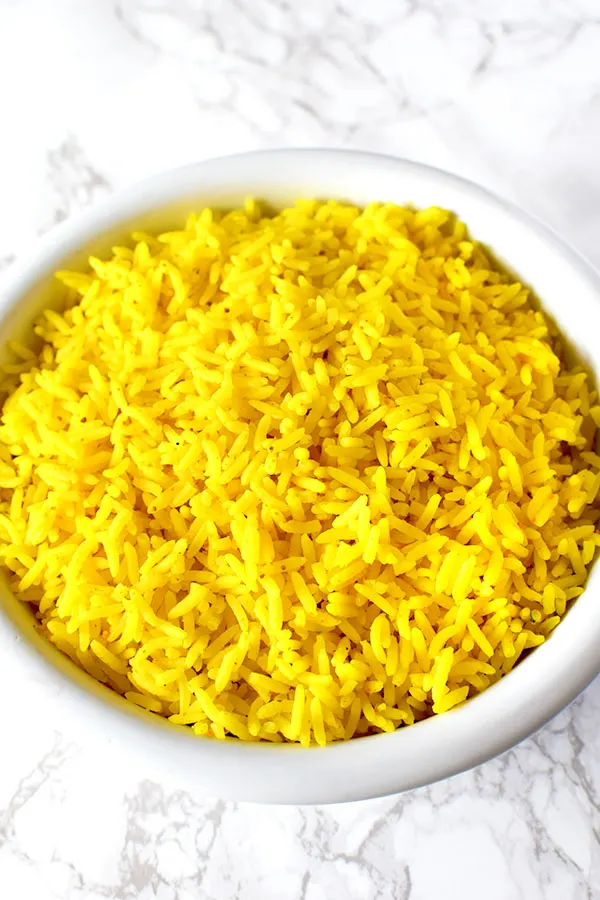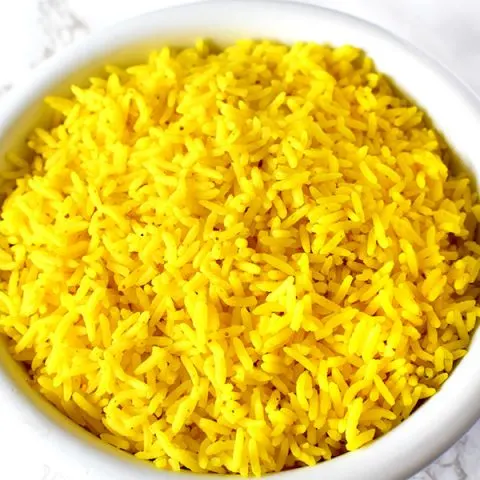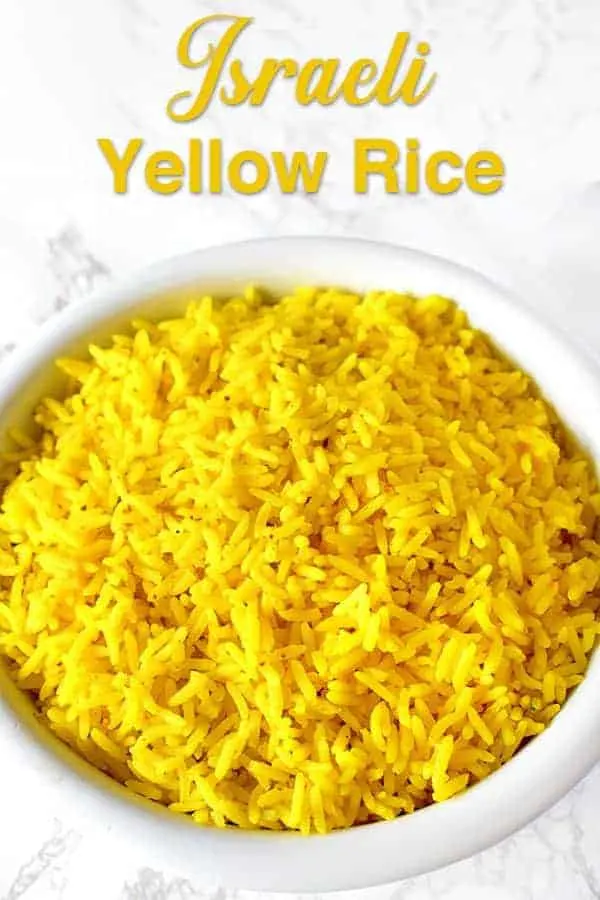Israeli yellow rice is a popular side dish in Israel. It's even almost as common as Israeli white rice. It is most commonly served with chicken, meatballs, or fish, alongside veggies.

My family doesn't sit down to eat together a lot, but when we do, there is yellow rice on the table.
Israeli white rice also always makes an appearance, and Israeli red rice does too occasionally, but if it was up to my mom, we'd just have yellow rice.
Once, when we were already pressed for time, my mom added too much turmeric to the pot of rice. When it was finished and we tasted it for good measure, it tasted like soap!
My mom was convinced that whoever did the dishes somehow forgot to rinse the pot.
It was only later that we figured out that too much turmeric gives a soapy taste. We were really grateful for the additional white rice that week, let me tell you! Since then, I make the yellow rice because I measure everything.
My family always makes this dish plain, but on occasion you can also find it made with peas, carrots, onions, chickpeas, red peppers, or even cranberries.
Based on what I've seen, plain and with chickpeas are by far the most popular - and my personal favorite.
WHY SORT RICE
Sorting rice is useful because I’ve actually found bugs in rice before, especially with already opened bags of rice.
To be sure the rice is clean, measure out how much rice you need, then pour some of it out onto a white plate.
Sift through the rice to make sure there are no bugs – some of which look like small worms.
When done, pour the sorted rice into a pot and repeat with the remaining rice.
As a secondary step, I then fill the pot with water and agitate the rice with my fingers. This helps get anything that may have been missed to float to the top.
Pour out the water, and if you found anything, repeat until nothing comes up.
HOW TO STORE DRY RICE
Store the remaining dry rice by placing it in an airtight container or a resealable plastic bag. Keep it in a cool, dark place.
Doing so will protect the rice from bugs.
I always check the rice before using it even when it is stored well, just in case.
WHY WASH RICE
There are three benefits to rinsing rice.
Firstly, it removes any debris.
Secondly, it removes surface starch. If the starch is not removed, it can cause the rice to clump together and get gummy as it cooks.
Thirdly, if there are any bugs in the rice that weren't caught, they will float to the surface while being washed.
Some say to rinse the rice repeatedly until the water runs clear. This isn’t necessary.
Instead, rinse the rice thoroughly a few times. After that, most of the starch should be removed and the water should be only slightly cloudy.
The way I like to wash rice is by putting it in a large bowl or a pot and filling it with water. Then, I shape my hand into a claw and use it to agitate the rice.
This brings up both debris and bugs that may have been missed during sorting.
WHY TOAST RICE
Toasting rice is a step some recipes require where you first lightly fry the uncooked rice. This step is usually done with rice that has not been rinsed.
As with toasting spices and nuts, toasting grains before cooking can enhance their flavor.
Rice is no exception, as it gains a nutty depth which adds an extra layer of flavor to a final dish.
Another benefit is that by toasting the rice first, you are cooking the starches.
This, like washing rice, helps prevent the rice from being sticky. Instead, each grain cooks separately.
RATIO WATER TO RICE
There are many different types of rice. The most popular types require two cups of water for one cup of rice. Some, however, need less water:
Short Grained Rice needs 1 and ⅛ cups water.
Basmati Rice needs 1 and ¼ cups water.
American Long Grain Rice needs 1 and ½ cups water.
Jasmine Rice needs 1 and ¾ cups water.
Also, when multiplying the recipe, rice often needs less water than you’d think. For example, with American long grain rice:
1 cup rice needs 1 and ½ cups water.
2 cups rice need 2 and ¾ cups water.
3 cups rice need 3 and ½ cups water.
HOW TO STORE RICE
Transfer the cooled, cooked rice into an airtight storage container or a resealable plastic bag. Make sure to remove as much air from the bag as possible before sealing it.
Store in the refrigerator for 3 to 5 days.
HOW TO FREEZE RICE
Transfer the cooled, cooked rice into a resealable freezer bag, making sure to remove as much air from the bag as possible before sealing.
Store for up to 6 months. After that, it is still safe to eat, but the quality begins to degrade.
REHEATING RICE
FROM THE FRIDGE
When reheating, place the rice in a pot, sprinkle a teaspoon of water over the top to help loosen stuck, dried grains, then place.
Heat over medium heat, stirring constantly to keep the grains moving, but be careful not to mash them.
FROM FREEZER
Frozen grains can be added directly to hot dishes like stir-fries. If you’re planning on eating it on its own, follow the steps above.
Israeli Yellow Rice SNAFU:
Be very careful not to add too much turmeric.
This happened a couple times in my house. Once because my mother never measures anything, and once because I couldn't find measuring spoons.
Both times, the rice came out tasting very soapy.
Also, do not try adding the turmeric after the rice is already made. We tried this once, and the rice ended up with a dry texture.
Israeli Yellow Rice

This yellow rice is the most popular in Israel right after white rice. It can be made alone or with vegetables such as chickpeas mixed in. Serve with chicken, meat, or fish.
Ingredients
- 1 cups rice (225 grams)
- 2 tablespoons oil*
- ½ teaspoon turmeric
- 2 cups boiling water (480 grams)
- 2 teaspoons chicken bouillon powder, vegetarian**
- pinch pepper
Instructions
- Coat the bottom of the pot in a thin layer of oil. When the oil is hot, add the rice and lightly fry.
- Stir in the turmeric and pepper. Fry for about 15 seconds.
- Add the boiling water and the bullion powder. Mix well.
- Let the pot simmer until the rice is fully cooked.
Notes
*For a lighter alternative, skip the oil and frying the rice. To do this, just place all the ingredients into a pot and boil until ready.
**Most bouillon powders have salt added. However, for low sodium powders, add salt to taste.
Nutrition Information:
Yield:
6Serving Size:
1Amount Per Serving: Calories: 78Total Fat: 5gSaturated Fat: 0gTrans Fat: 0gUnsaturated Fat: 4gCholesterol: 1mgSodium: 4mgCarbohydrates: 8gFiber: 0gSugar: 0gProtein: 1g

Marie
Thursday 19th of June 2025
Dear ElissaBeth, I typed in google “Israel yellow rice” and found your recipe. I am a Christian and our church had an authentic Israel dinner tonight and all the donations are going to support our beloved country of our Messiah Yeshua. The food was so delicious I had to know how to make it at home. Thank you for posting this recipe and for your warning about measuring because I need to be told to measure or I won’t be good about it. The Lord bless you.
ElissaBeth
Friday 20th of June 2025
Thank you so much for touching comment ❤️ I hope you enjoy the recipe as much as you did at your event :)
Dorothy Cassard
Thursday 9th of June 2022
Sometimes eat cold yellow rice salad at Sofra Kebabs, but it has a special taste, and i would like to know what is the flavour. It really tastes wonderful. Do you know what's the flavour?
Monday 12th of September 2022
@Dorothy Cassard, it is probably whole allspice berries and bay leaves. I add 1-2 leaves and 4 berries per 1-2 cups uncooked rice.
ElissaBeth
Thursday 16th of June 2022
I'm sorry but I've never been to that restaurant so I couldn't say
Laura Cardinal
Thursday 4th of June 2020
Hi Elissabeth,
Could I substitute chicken broth for the water and chicken bullion powder?
Thanks, Laura
ElissaBeth
Thursday 4th of June 2020
That is not how Israeli's make it so I don't think it will taste exactly the same, but it should work just fine.
Tuesday 14th of January 2020
What kind of rice ?
ElissaBeth
Tuesday 14th of January 2020
I've tried it with both long and medium grained rice. I didn't have a problem with either, so your choice. There are notes in the body about different types of rice and how much water each needs.
Cynthia Levinson
Wednesday 8th of May 2019
If you want to make the Israeli Yellow Rice with chickpeas, how much (drained canned?) chickpeas do you use, and at what stage of cooking do you add them?
ElissaBeth
Wednesday 8th of May 2019
I'd probably use a half a can and mix in after the rice is cooked but while it is still hot enough to warm up the chickpeas.